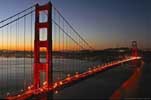"San Francisco has only one drawback. 'Tis hard to leave." ~ Rudyard Kipling
When San Francisco's Golden Gate Bridge opened to vehicular traffic at twelve o'clock noon on this day in 1937, the toll was 50 cents each way, with a five-cent charge for three passengers or more.
Over 60 years later, more than 42 million vehicles crossed the 1.7 mile-long engineering marvel annually. The bridge was named after the Golden Gate Strait at the entrance of San Francisco Bay from the Pacific.
Glistening like a beacon through the fog and sunlight, the bridge was painted orange vermilion, a color called "International Orange," to blend well with the span's natural setting.
"I regret that I have but one life to live in San Francisco," admitted columnist Herb Caen.
To build the longest span of its time, engineer Joseph Baerman Strauss (1870-1938), overcame the fierce wind, pounding Pacific currents and critics who said the 4,200-foot all-suspension construction couldn't be done.
With innovation, he introduced the use of hard hats and a safety net that stretched the length of the bridge. In the middle of the Great Depression, Strauss held on to his vision to build the Golden Gate Bridge in four and a half years.
"The Golden Gate Bridge, the bridge that could not and should not be built...stands before you in all its majestic splendor," Strauss said.
When asked how long he thought his bridge would stand, Strauss replied, "Forever."
Visit: Golden Gate Bridge Site
 San Francisco, a miracle in the mist.
San Francisco, a miracle in the mist.
